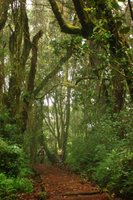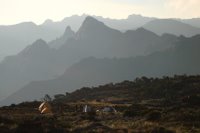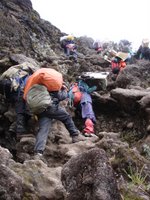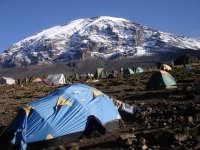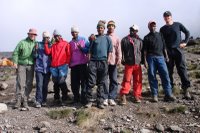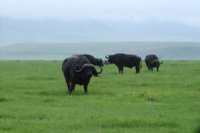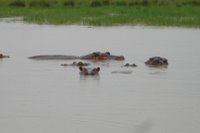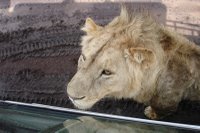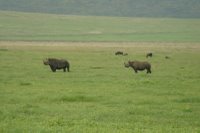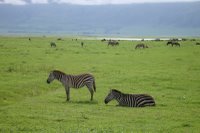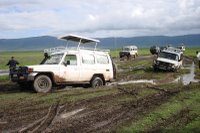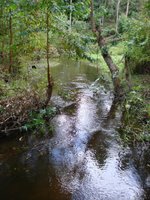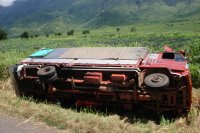January Update
Camp Life
We have been keeping busy in the slow periods by building small things such as tables and shelves, doing lots of reading, and taking on other small projects. I drew a large map of Africa and Uganda on the outside wall of our new office building. A typical day now involves waking around 7:30 and having breakfast which is generally cold leftovers from the night previous and occasionally some fruit. If we’re going with the crew, we usually leave around 8:30 and usually work until 12:30 and travel back to camp. Lunch at 1:00 and work resumes around 2:00. The day ends around 16:30 or 17:00. Tea is at 5:30 and dinner at 7:30. There is a lot of downtime during periods of the day which can be filled with either reading or a small project, or a choir. Washing clothes is time consuming as it has to be done manually in a basin. It’s a pretty routine life at our camp but it is easy to get used to.
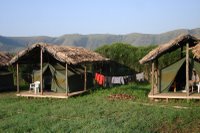 A couple of the tents where the Canadians stay. There are now 6 tents set up
A couple of the tents where the Canadians stay. There are now 6 tents set up The main building of our camp. The Ugandan crew have rooms in here and the mess and office are attached
The main building of our camp. The Ugandan crew have rooms in here and the mess and office are attached A sunset from the camp
A sunset from the camp I drew a map of Africa and Uganda on the back wall of our new office building so I would have something to look at when Im sitting idle outside my tent
I drew a map of Africa and Uganda on the back wall of our new office building so I would have something to look at when Im sitting idle outside my tentSoccer
Last week there was a big soccer game near our camp. It was between a nearby team and a team from ‘just over the hills’. The Ugandans are amazing athletes and it was awesome to watch a real African soccer game. First of all, the field is anything but flat: there are small hills and depressions all over the place. The grass level is maintained by animals grazing so it is quite long to the point you can’t always see the ball when you’re watching. Most players don’t have cleats and probably half don’t even have shoes. They play very aggressively but also have a very high skill level. Overall it was very impressive and my new goal is to view a professional African soccer game if I can make it happen.
 Local soccer game
Local soccer game
Local soccer game
 Local soccer game
Local soccer gameKikigati Trip
Kikigati is a border-town on the river that divides Uganda and Tanzania. There are some water and agriculture project there and the interns and employees there stay in a small house that is rented. It is a little over an hour from our camp and feels really different than where we stay. The house they are in is right in the middle of a trading center so they are not isolated at all. This means they get to see a better picture of real life in Uganda but they are also subject to constant pestering from the locals, especially the kids. We sit in the living room and kids just lurk outside the window staring in. They also get a lot of visits from uninvited people which can occur at awkward times. But it is a cool place and great to visit. We spent Saturday driving out to see the local pod of hippos that lives in the river nearby. It was cool to see hippos in real life outside a game park even though they were a long ways away. We also visited the site of a former hydroelectric power station that was destroyed in 1979 during the war Amin started with Tanzania that led to his downfall. It is such a waste in a country that has significant power shortages and is pumping all their money into their military.
 The ACTS truck parked in front of the house. We borrowed the truck battery so we could watch a movie (the solar power ran out) and just bomb started the truck the next morning
The ACTS truck parked in front of the house. We borrowed the truck battery so we could watch a movie (the solar power ran out) and just bomb started the truck the next morning John buying some goat meat for dinner. They made an amazing goat curry for dinner
John buying some goat meat for dinner. They made an amazing goat curry for dinner The landlord's kids playing outside the house
The landlord's kids playing outside the house What would a trip to see the hippos be without a cheesy machete photo?
What would a trip to see the hippos be without a cheesy machete photo? Some of the local longhorn cattle
Some of the local longhorn cattle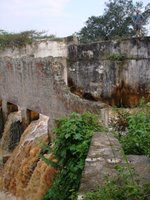
Part of the old hydroelectric station foundation on the Kagera River on the border of Uganda and Tanzania
UN Millennium Village Visit
The trip to Kikigati was made because we were invited to visit the UN Millennium Village on Sunday, Jan 14. It was a tour set up for Jeffery Sachs, the Director of the UN Millennium Project, and George Osborne, a British MP. They invited some local NGOs in the area to attend. UN Millennium Goal #8: Building Relationships. The day started with maybe 2 or 3 dozen people and by the end of the day there were more than a hundred people following the tour around. The UN Millennium Village is basically a typical Ugandan village that is being used a model of the effects of increasing foreign aid. They sink a tonne of money into the community and measure the effects. Sachs’ economic view is that foreign aid to Africa needs to increase more than 3-fold in order to solve Africa’s problems. It is a controversial view. So the UN pumps money into schools, health centers, farms, and people’s homes, and at the end of 5 years if all goes well it will be a model village for dumping money into Africa. The project is 6 months in so far. They have one piece of data that I’m sure can be proved: they gave everyone in the community mosquito nets and they have marked significant decreases in cases of malaria. The overall question of the project is of sustainability. If the money stops flowing than many of the projects will stop, specifically regarding agriculture (inorganic fertilizers and GE seeds that no local Ugandans can possibly afford), and other projects will deteriorate slowly. To me this means the aid has to continue until economic development occurs which has the potential to be a very long time. Regardless, the experience was unique and stimulated a lot of interesting discussion. Just to see the circus that follows important people around and the hectic life of a politician was cool.
 Sachs was the center of attention of day long. It seems like a stressful position to me
Sachs was the center of attention of day long. It seems like a stressful position to me Meeting Jeffery Sachs
Meeting Jeffery Sachs George Osborne, the British MP, kept giving these strange interviews to his assistant with the camera. We were joking that he could easily be mistaken for a BBC correspondant in the field
George Osborne, the British MP, kept giving these strange interviews to his assistant with the camera. We were joking that he could easily be mistaken for a BBC correspondant in the field Some smiling kids. This ones for my mom
Some smiling kids. This ones for my mom This guy was cool. He was based in Nairobi and in charge of the Millenium Project for East Africa. I could tell he didnt like the polical side of things. He was joking that he has trees planted all across East Africa and that half of them are probably dead
This guy was cool. He was based in Nairobi and in charge of the Millenium Project for East Africa. I could tell he didnt like the polical side of things. He was joking that he has trees planted all across East Africa and that half of them are probably dead
The day ended at a big event where thousands of people were waiting for us. It was really unexpected but then evenything on this day was unexpected. There was a stage and sound system set up and a bunch of local politicians spoke as well as Sachs.
ACTS Pipeline Work Mobilization Party
Yesterday was the party to mobilize the community members in the area to start work tomorrow. There is around 16km of trench that has to be dug for the pipeline and it is Jim’s tactic to have a party to build enthusiasm. He invites people from previous water projects and local politicians to build excitement about the project. Also two cows were killed and cooked. Imagine the logistics of cooking two whole cows. And I mean whole, nothing is wasted. The party seemed successful and there were probably at least a thousand people in attendance. I guess tomorrow we will see how many people show up to work.
 Cooking an absolutely huge pot of Matoke, steamed bananas which a staple part of the diet here.
Cooking an absolutely huge pot of Matoke, steamed bananas which a staple part of the diet here.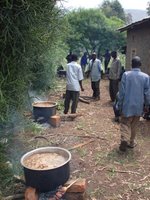
An example of one of the six groups cooking the cow for the party

We had a good size crowd, I think at least a thousand
 Jim Doble and Apollo, our crew foreman, speaking to the crowd
Jim Doble and Apollo, our crew foreman, speaking to the crowd